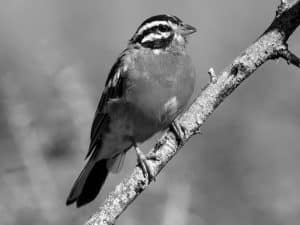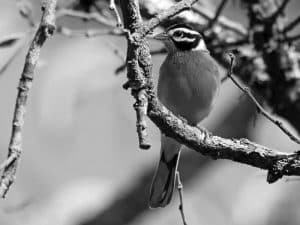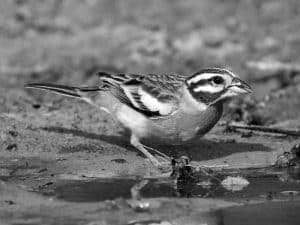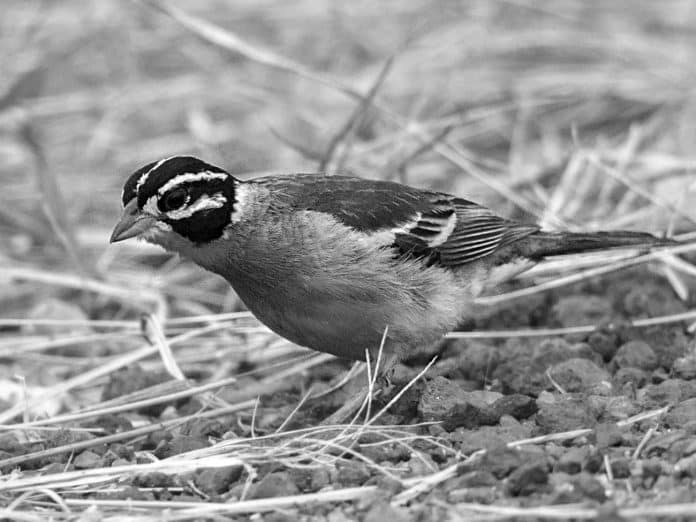Introduction to the Golden-Breasted Bunting
The golden-breasted bunting is a captivating bird species found in the vibrant landscapes of Tanzania. This striking songbird, with its vibrant plumage and melodic calls, has captivated the hearts of birdwatchers and nature enthusiasts alike. As you embark on a journey to explore the avian wonders, the golden-breasted bunting in Tanzania stands out as a true gem, waiting to be discovered.

In this comprehensive guide, we will delve into the fascinating world of the golden-breasted bunting, uncovering its unique habitat, physical characteristics, behaviors, and conservation status. You’ll also learn about the best birdwatching opportunities to spot this elusive species, as well as valuable tips to enhance your wildlife photography experiences. Join us as we celebrate the beauty and rarity of this remarkable bird, and discover why the golden-breasted bunting is a true treasure of Tanzania’s avian kingdom.
Habitat and Distribution of the Golden-Breasted Bunting in Tanzania
The golden-breasted bunting is primarily found in the eastern and central regions of Tanzania, thriving in a diverse range of habitats. These resilient birds have adapted to thrive in various ecosystems, including:
- Acacia Woodlands: The golden-breasted bunting is often spotted in the sprawling acacia woodlands, where the dappled sunlight filters through the canopy, creating a captivating backdrop for their vibrant plumage.
- Miombo Woodlands: This bird species also calls the expansive miombo woodlands, characterized by a mosaic of tall trees and open grasslands, its natural home.
- Montane Forests: In the lush, high-altitude forests of Tanzania, the golden-breasted bunting can be found flitting among the dense foliage, adding a touch of color to the verdant landscape.
- Riverine Habitats: Along the banks of Tanzania’s rivers and streams, the golden-breasted bunting thrives, taking advantage of the abundant food sources and sheltered nesting sites.
Across these diverse habitats, the golden-breasted bunting can be found in various regions of Tanzania, including the Serengeti National Park, Tarangire National Park, and the Udzungwa Mountains, among others. Understanding the bird’s preferred environments is crucial for birdwatchers seeking to catch a glimpse of this elusive species.
Physical Characteristics and Behaviors of the Golden-Breasted Bunting
The golden-breasted bunting is a true feast for the senses, with its captivating appearance and intriguing behaviors. Let’s delve into the details that make this bird so unique:
Physical Characteristics:
- Vibrant Plumage: The golden-breasted bunting is adorned with a striking combination of colors, including a brilliant golden-yellow breast, a black head, and a distinctive white eyebrow.
- Compact Build: This songbird has a compact, rounded body, with a short, conical beak and relatively short legs, which aid in its agile movements through the dense vegetation.
- Distinctive Tail: The golden-breasted bunting’s tail is slightly forked, adding a touch of elegance to its overall appearance.
Behaviors:
- Melodic Calls: The golden-breasted bunting is known for its melodic and varied calls, which can be heard echoing through the woodlands, often used to communicate with its flock or defend its territory.
- Foraging Habits: These birds are primarily seed-eaters, but they also supplement their diet with insects, berries, and other small invertebrates, often foraging in small groups or pairs.
- Nesting Preferences: The golden-breasted bunting constructs its nest in the dense foliage of trees or shrubs, weaving a cup-shaped structure using a variety of natural materials.
By understanding the physical characteristics and behaviors of the golden-breasted bunting, you’ll be better equipped to spot and appreciate this captivating species during your birdwatching adventures in Tanzania.
Conservation Status and Threats to the Golden-Breasted Bunting

The golden-breasted bunting, though a stunning and iconic species, faces a number of challenges to its long-term survival. Let’s explore the current conservation status and the threats that this bird species is facing:
Conservation Status:
- The golden-breasted bunting is classified as a Least Concern species by the International Union for Conservation of Nature (IUCN), indicating that its global population is relatively stable.
- However, some regional populations may be facing more significant threats, and the species’ long-term survival requires ongoing monitoring and conservation efforts.
Threats:
- Habitat Loss: The conversion of natural habitats, such as acacia and miombo woodlands, into agricultural land or urban development, poses a significant threat to the golden-breasted bunting’s preferred living spaces.
- Illegal Wildlife Trade: The demand for exotic birds in the pet trade has led to the illegal capture and trafficking of golden-breasted buntings, further endangering their populations.
- Climate Change: Shifts in temperature and precipitation patterns due to climate change can disrupt the delicate balance of the golden-breasted bunting’s ecosystems, potentially affecting its food sources and breeding patterns.
To ensure the continued presence of the golden-breasted bunting in Tanzania’s avian landscape, conservation organizations and local communities are working together to implement various strategies, such as habitat restoration, anti-poaching initiatives, and public awareness campaigns. By understanding the challenges facing this species, you can become an active advocate for its protection and support the ongoing efforts to safeguard its future.
Birdwatching Opportunities for Spotting the Golden-Breasted Bunting in Tanzania
Tanzania’s diverse landscapes offer numerous opportunities for birdwatchers to catch a glimpse of the elusive golden-breasted bunting. Here are some of the best destinations and tips to increase your chances of spotting this avian treasure:
Top Birdwatching Destinations:
- Serengeti National Park: The expansive grasslands and acacia woodlands of the Serengeti provide an ideal habitat for the golden-breasted bunting, making it a prime location for birdwatchers.
- Tarangire National Park: This park is known for its diverse avifauna, including the golden-breasted bunting, which can be found in the park’s miombo woodlands and riverine habitats.
- Udzungwa Mountains National Park: The lush, montane forests of the Udzungwa Mountains are a stronghold for the golden-breasted bunting, offering opportunities to spot this species in a stunning, high-altitude setting.
Birdwatching Tips:
- Timing is Key: The golden-breasted bunting is most active and visible during the early morning and late afternoon hours, when it is more likely to be foraging or singing.
- Patience and Stealth: These birds can be elusive, so it’s important to move slowly and quietly, keeping an eye out for movement and listening for their distinctive calls.
- Utilize Local Guides: Joining a birdwatching tour with experienced local guides can greatly increase your chances of spotting the golden-breasted bunting, as they are familiar with the bird’s preferred habitats and behaviors.
By following these tips and exploring the prime birdwatching destinations in Tanzania, you’ll be well on your way to adding the golden-breasted bunting to your list of sightings, and immersing yourself in the vibrant world of Tanzania’s avian wonders.
Tips for Birdwatching and Photographing the Golden-Breasted Bunting

Capturing the beauty of the golden-breasted bunting through photography can be a rewarding and challenging pursuit. Here are some valuable tips to help you make the most of your birdwatching and photography experiences:
Birdwatching Tips:
- Invest in High-Quality Binoculars: Equip yourself with a pair of high-quality binoculars to enhance your ability to spot and observe the golden-breasted bunting’s intricate features.
- Familiarize Yourself with Calls: Learn to recognize the distinctive calls and vocalizations of the golden-breasted bunting, as this can help you locate these elusive birds in the field.
- Respect the Birds’ Habitat: Avoid disturbing the birds’ natural behaviors and nesting sites, as this can have a negative impact on their well-being.
Photography Tips:
- Use a Telephoto Lens: Invest in a high-quality telephoto lens to capture close-up, detailed images of the golden-breasted bunting, as they can be skittish and difficult to approach.
- Shoot in Early Morning or Late Afternoon: Take advantage of the soft, warm light during the golden hours to capture the best-lit and most vibrant images of the golden-breasted bunting.
- Blend In with the Environment: Wear neutral-colored clothing and use camouflage techniques to blend in with the surrounding vegetation, minimizing your presence and increasing your chances of capturing unobtrusive shots.
By following these tips and honing your birdwatching and photography skills, you’ll be well on your way to capturing stunning images and unforgettable memories of the golden-breasted bunting in its natural habitat.
Other Avian Species Found in the Same Habitat as the Golden-Breasted Bunting
The golden-breasted bunting is not the only avian treasure to be found in Tanzania’s diverse ecosystems. Alongside this captivating species, you’ll have the opportunity to spot a variety of other fascinating birds, including:
- Lilac-Breasted Roller: This vibrant, rainbow-colored bird is a common sight in the acacia woodlands, often perching on exposed branches.
- Superb Starling: With its iridescent plumage and striking yellow eye, the superb starling is a frequent companion to the golden-breasted bunting in the miombo woodlands.
- Hoopoe: The distinctive crest and striking black-and-white pattern of the hoopoe make it a visually striking addition to the avian diversity of Tanzania’s montane forests.
- Bateleur Eagle: This majestic raptor, with its distinctive red face and tilted flight, can be spotted soaring above the Serengeti’s expansive grasslands.
- Crowned Hornbill: The large, distinctive beak and vibrant plumage of the crowned hornbill make it a captivating species to observe in the riverine habitats.
By broadening your birdwatching horizons and exploring the diverse array of avian species found in the same habitats as the golden-breasted bunting, you’ll gain a deeper appreciation for the richness and complexity of Tanzania’s avian kingdom.
Conservation Efforts and Organizations Working to Protect the Golden-Breasted Bunting
Recognizing the importance of preserving Tanzania’s avian treasures, various conservation organizations and local communities have dedicated their efforts to safeguarding the golden-breasted bunting and its fragile habitats. Here are some of the key players in this vital mission:
Conservation Organizations:
- Tanzania Wildlife Research Institute (TAWIRI): This government agency is responsible for conducting research and implementing conservation strategies to protect Tanzania’s wildlife, including the golden-breasted bunting.
- BirdLife International: As a global partnership of conservation organizations, BirdLife International works to identify and protect Important Bird and Biodiversity Areas (IBAs), which include the habitats of the golden-breasted bunting.
- Wildlife Conservation Society (WCS): WCS has a strong presence in Tanzania, collaborating with local communities and authorities to combat illegal wildlife trade and promote sustainable land-use practices that benefit species like the golden-breasted bunting.
Community-Based Initiatives:
- Village Conservation Committees: These local groups work with conservation organizations to monitor and protect the natural habitats within their communities, ensuring the golden-breasted bunting and other wildlife can thrive.
- Ecotourism Enterprises: Sustainable ecotourism initiatives that promote birdwatching and wildlife viewing provide economic incentives for local communities to preserve the golden-breasted bunting’s habitat.
By supporting these conservation efforts and organizations, you can play a vital role in ensuring the long-term survival of the golden-breasted bunting and the overall health of Tanzania’s avian ecosystems.
Interesting Facts about the Golden-Breasted Bunting
As you delve deeper into the world of the golden-breasted bunting, you’ll uncover a wealth of fascinating facts about this captivating species. Here are a few intriguing tidbits that will add to your appreciation of this avian treasure:
- The golden-breasted bunting is a member of the Emberizidae family, a diverse group of small, seed-eating birds found primarily in the Americas and Eurasia.
- Despite its vibrant appearance, the golden-breasted bunting is relatively small, measuring only about 12-14 centimeters in length.
- These birds are known for their complex and varied vocalizations, which include a melodic, trilling song and a distinctive “chik-chik-chik” call.
- The golden-breasted bunting is a monogamous species, with pairs often remaining together for multiple breeding seasons.
- In the breeding season, the male golden-breasted bunting will perform elaborate courtship displays, including flying in a distinctive zig-zag pattern and fanning out its tail feathers.
- The golden-breasted bunting’s nest is a carefully crafted cup-shaped structure, woven from a variety of natural materials like grass, twigs, and animal hair.
- These birds are primarily seed-eaters, but they also supplement their diet with insects, berries, and other small invertebrates, particularly during the breeding season when they need to provide for their young.
By delving into these fascinating facts, you’ll gain a deeper appreciation for the unique adaptations and behaviors that make the golden-breasted bunting such a captivating species within Tanzania’s avian kingdom.
Conclusion: Appreciating the Beauty and Rarity of the Golden-Breasted Bunting in Tanzania
As you conclude your journey of discovery, it’s clear that the golden-breasted bunting is a true avian treasure, worthy of our utmost appreciation and conservation efforts. This vibrant songbird, with its striking plumage and melodic calls, is a testament to the incredible diversity and beauty found within Tanzania’s natural landscapes.
To continue your exploration of Tanzania’s avian wonders, consider joining a guided birdwatching tour or reaching out to local conservation organizations to learn about opportunities to support their efforts in protecting the golden-breasted bunting and its fragile habitats. By immersing yourself in the world of this captivating species, you can become an advocate for its preservation and contribute to the long-term sustainability of Tanzania’s rich avian ecosystems.
Whether you’re a seasoned birdwatcher or a nature enthusiast, the golden-breasted bunting is a species that will captivate your senses and leave a lasting impression. As you venture forth to discover this avian gem, remember to approach your experiences with respect, curiosity, and a deep appreciation for the natural world that surrounds you. By doing so, you’ll not only witness the beauty of the golden-breasted bunting but also play a vital role in ensuring its continued presence in Tanzania’s avian tapestry for generations to come.

































